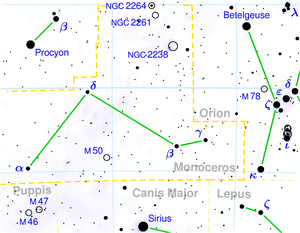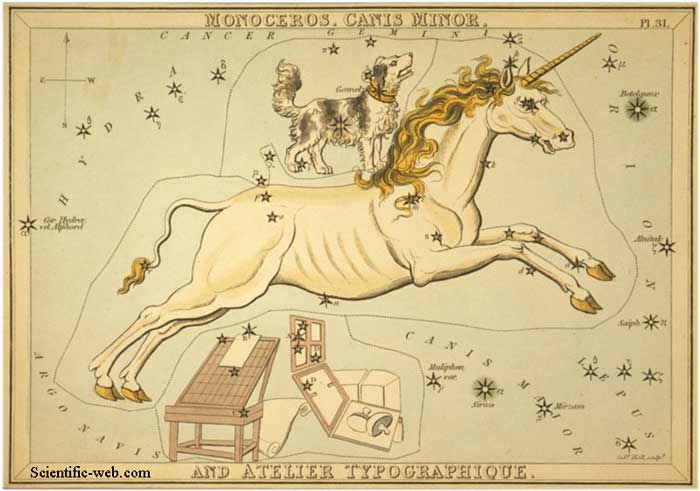
|
Monoceros (Greek: Μονόκερος) is a faint constellation in the winter night sky, surrounded by Orion to the west, Gemini to the north, Canis Major to the south and Hydra to the east. Other bordering constellations include Canis Minor, Lepus and Puppis. Notable features Monoceros is a constellation that is not very easily seen with the naked eye, with only a few fourth magnitude stars. Alpha Monocerotis has a visual magnitude of 3.93, slightly brighter than Gamma Monocerotis, which has a visual magnitude of 3.98. However, Monoceros does have some interesting features to observe with the aid of a small telescope. Beta Monocerotis is an impressive triple star system, the three stars form a triangle which seems to be fixed. The visual magnitudes of the stars are 4.7, 5.2 and 6.1. William Herschel discovered it in 1781 and commented that it is 'one of the most beautiful sights in the heavens'. Epsilon Monocerotis is a fixed binary, with visual magnitudes of 4.5 and 6.5. S Monocerotis, or 15 Monocerotis, is a bluish white variable star and is located at the center of NGC 2264. However the variation of its magnitude is not too great. It has a companion star of visual magnitude 8. V838 Monocerotis had an outburst starting on January 6, 2002. Monoceros also contains Plaskett's Star, which is a massive binary system estimated to be almost 100 Suns put together. Notable deep sky objects Monoceros contains many clusters and nebulae, most notable among them; * M50, an open cluster * The Rosette Nebula (NGC 2237-9,46), a diffuse nebula * The Christmas Tree Cluster and associated Cone Nebula (NGC 2264) History Monoceros is a modern constellation. Its first certain appearance is on the globe by the Dutch cartographer Petrus Plancius in 1612 or 1613, and was later charted by Jakob Bartsch as Unicornus in his star chart of 1624. Heinrich Wilhelm Olbers and Ludwig Ideler [1] indicate the constellation may be older, quoting an astrological work [2] from 1564 that mentioned "the second horse between the Twins and the Crab has many stars, but not very bright"; these may ultimatly be due to Michael Scot of the 13th century, but refer to a horse and not a unicorn, and its position does not quite match. Joseph Scaliger is reported [3] to have found it on an ancient Persian sphere.
Monoceros, Canis Minor, and Atelier Typographique Citations 1. ^ Ideler, Ludwig (1809). Untersuchungen über den Ursprung und die Bedeutung der Sternnamen: Ein Beytrag zur Geschichte des gestirnten Himmels. Berlin, 354..355. 2. ^ (1564) Himmels Lauffs Wirkung und natürliche Influenz der Planeten Gestirne und Zeichen aufs Grund der Astronomie. Frankfurt. 3. ^ Allen, Richard Hinckley (1963 (1899)). Star Names - their lore and meaning. Dover, 290. References * Ian Ridpath and Wil Tirion (2007). Stars and Planets Guide Links
Retrieved from "http://en.wikipedia.org/"
|
|
||||||||||||||||||||||||||||||||||||||||||||||||||||

